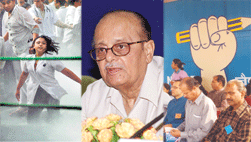 The decade 1999-2009, since Education World was promoted (1999) with the mission of “building the pressure of public opinion to make education the No.1 item on the national agenda”, has witnessed the once back-burner subject of education and development of the nation’s abundant human resources, steadily moving towards the centre of the national development debate.
The decade 1999-2009, since Education World was promoted (1999) with the mission of “building the pressure of public opinion to make education the No.1 item on the national agenda”, has witnessed the once back-burner subject of education and development of the nation’s abundant human resources, steadily moving towards the centre of the national development debate.
In this special 10th Anniversary issue of India’s sole education news and analysis (monthly) magazine, assistant editor Summiya Yasmeen presents a chronological retrospective of landmark education initiatives and developments of the past decade.
Victory for English in Tamil Nadu
April 20, 2000. The Madras high court quashed a state government order mandating Tamil as the sole medium of instruction from class I-V for all primary schools across the state. The court ruled that the government order violated the fundamental right to education, which includes the right of parents to choose the medium of instruction of their children.
ISB comes on stream
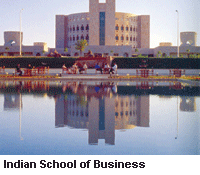 July, 2001. The Indian School of Business became operational on a 250-acre campus in Hyderabad in the first week of July. Promoted by the CEOs of several private blue-chip corporates in academic collaboration with the Kellogg School of Management, Wharton Business School and the London Business School, ISB is equipped with state-of-the-art infrastructure facilities.
July, 2001. The Indian School of Business became operational on a 250-acre campus in Hyderabad in the first week of July. Promoted by the CEOs of several private blue-chip corporates in academic collaboration with the Kellogg School of Management, Wharton Business School and the London Business School, ISB is equipped with state-of-the-art infrastructure facilities.
Lok Sabha approves 93rd Amendment
November 28, 2001. The Constitution (Ninety-third Amendment) Act 2001, which promises to deliver the dream of universal elementary education for all, was unanimously passed by the Lok Sabha. The Act added Article 21-A to the Constitution to provide free and compulsory education to all children of the age of six to fourteen years. (EW cover story January 2002)
Court bans corporal punishment
November 30, 2001. The Delhi high court struck down S.37 (4) (a) of the Delhi School Education Act 1973 and the rules thereunder which sanc-tioned corporal punishment in schools. The impugned section of the Act permitted headmasters to inflict corporal punishment upon school children.
Saffronisation of school textbooks
October 3, 2002. A new set of social science textbooks, with revised history inputs suspected of advancing the hindutva ideology of the ruling Bharatiya Janta Party, was ceremonially released by NCERT in Delhi, with the recommendation that all secondary schools and examination boards should incorporate them into their curriculums. (EW cover story March 2003).
Freedom charter for private professional education
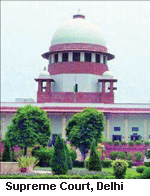 October 31, 2002. In a historic 318-page elaborately reasoned judgement in TMA Pai & Ors vs. State of Karnataka & Ors, a full strength 11-judge bench of the Supreme Court upheld the right of religious and linguistic minorities to establish and administer education institutions of their choice and in particular, to regulate admissions and determine their fee structures. Moreover the court expanded this right to all citizens. (EW cover story February 2003)
October 31, 2002. In a historic 318-page elaborately reasoned judgement in TMA Pai & Ors vs. State of Karnataka & Ors, a full strength 11-judge bench of the Supreme Court upheld the right of religious and linguistic minorities to establish and administer education institutions of their choice and in particular, to regulate admissions and determine their fee structures. Moreover the court expanded this right to all citizens. (EW cover story February 2003)
Bharat Shiksha Kosh bolt for IITs
May, 2003. Union HRD minister Dr. Murli Manohar Joshi issued a circular to all secondary and higher education institutes funded by the Central government, forbidding them from accepting any funding/donation without prior clearance from the Bharat Shiksha Kosh (BSK), a Central government sponsored trust for the education sector. Shortly thereafter BSK rejected a $10 million grant offered by US-based IT millionaire Gururaj Deshpande to his alma mater IIT-Madras.
Supreme Court clarifies professional education judgement
August 14, 2003. In a follow-up judgement to “clarify” the TMA Pai Foundation Case of October 2002, a five-judge constitutional bench of the Supreme Court whittled down the right of self-administration conferred upon private unaided professional colleges. In the Islamic Academy vs. State of Karnataka & Ors, the apex court upheld the right of state governments to determine management quotas and ordered formation of committees headed by retired judges to regulate admission procedures, and adjudicate whether tuition fees levied by professional education institutions are reasonable. (EW cover story September 2003)
Quota for Delhi private schools
January 20, 2004. The Delhi high court directed the state government to ensure that privately promoted unaided schools which had been allotted land at concessional prices by the Delhi Development Authority, grant freeships and admit poor, underprivileged children equivalent to 25 percent of their enrolment capacity. More than 1,200 schools in the national capital have been allotted public land at significantly reduced prices by DDA on this condition.
Union HRD ministry slashes IIM tuition fees
.gif) February 5, 2004. The Union HRD ministry issued a terse five paragraph order directing the country’s six Indian Institutes of Management to slash tuition-cum-residence fees payable by students by 80 percent, from Rs.1.5-1.75 lakh to a uniform Rs.30,000 per year. The order advised that “the compliance report in this regard be sent to the ministry urgently.” (EW cover story March 2004)
February 5, 2004. The Union HRD ministry issued a terse five paragraph order directing the country’s six Indian Institutes of Management to slash tuition-cum-residence fees payable by students by 80 percent, from Rs.1.5-1.75 lakh to a uniform Rs.30,000 per year. The order advised that “the compliance report in this regard be sent to the ministry urgently.” (EW cover story March 2004)
Arjun Singh takes charge
May 22, 2004. Following the unexpected defeat of the BJP-led NDA coalition in the general election, the septuagenarian Congress Party warhorse Arjun Singh took charge as Union minister of human resource development. Immediately upon assumption of office, Singh declared an intent to reverse the “saffronisation of Indian education”, and in particular, revision of hindutva-inspired changes in the history and social science textbooks published by National Council of Education Research & Training (NCERT).
Kumbakonam school fire tragedy
July 16, 2004. Ninety-three students of a government-aided primary school in Kumbakonam, Tamil Nadu lost their lives in a devastating fire which swept the Saraswathi English Medium School. The promoter and some staff were arrested and charged with criminal negligence. Following investigations, it came to light that the district chief educational officer and his staff had failed to conduct the mandatory annual inspection of the school for three years.
National Curriculum Framework 2005 presented
May 7, 2005. A draft National Curriculum Framework (NCF) 2005 for school education authored by NCERT was formally presented to the Central Advisory Board of Education (CABE). NCF 2005 was the outcome of a mountain of labour spread over ten months of 21 national focus groups supervised by a National Steering Committee comprising eminent academics and educationists, and chaired by former chairman of the University Grants Commission Prof. Yash Pal. (EW cover story July 2005)
National Knowledge Commission established
.gif) August 2, 2005. Prime minister Manmohan Singh formally inaugurated the National Knowledge Commission charged with the mission of transforming India into a full-fledged 21st century knowledge society. The brief of the commission chaired by Satyen (‘Sam’) Pitroda, the charismatic technologist-visionary and comprising a stellar panel of members including intellectuals, businessmen and academics, is to “build excellence in the educational system to meet the knowledge challenges of the 21st century”; energise the country’s moribund science and technology laboratories; promote knowledge application in agriculture and industry, and install workable e-governance systems towards “making government an effective, transparent and accountable service provider”. (EW cover story November 2005)
August 2, 2005. Prime minister Manmohan Singh formally inaugurated the National Knowledge Commission charged with the mission of transforming India into a full-fledged 21st century knowledge society. The brief of the commission chaired by Satyen (‘Sam’) Pitroda, the charismatic technologist-visionary and comprising a stellar panel of members including intellectuals, businessmen and academics, is to “build excellence in the educational system to meet the knowledge challenges of the 21st century”; energise the country’s moribund science and technology laboratories; promote knowledge application in agriculture and industry, and install workable e-governance systems towards “making government an effective, transparent and accountable service provider”. (EW cover story November 2005)
Supreme Court frees professional education colleges
August 12, 2005. A seven-judge bench of the Supreme Court struck down the prevalent practice of state governments appropriating more than 60-85 percent of capacity in privately promoted unaided (i.e financially independent) medical and engineering colleges across the country for students topping CETs (Common Entrance Tests) of state governments. In a unanimous judgement in P.A. Inamdar vs. State of Maharashtra, the apex court upheld and reaffirmed its earlier verdict in TMA Pai Foundation Case (2002) which had freed privately promoted unaided colleges of professional education countrywide, from state government stipulated caste-based reservations and government mandated tuition fees. (EW cover story October 2005)
Right to Education Bill, 2005 drafted
October, 2005. Following the recommendations of the Kapil Sibal Committee, a composite new Right to Education Bill, 2005 was drafted and approved by the Union HRD ministry. The most controversial recommendation of the Bill is the mandatory reservation of 25 percent seats for neighbourhood “children belonging to the weaker sections” in class I of all private aided and unaided schools countrywide. (EW cover story September 2005)
Constitutional amendment for quotas
December 21, 2005. Parliament unanimously approved the 104th Constitutional Amendment Bill, 2005 restoring reserved quotas for scheduled castes (15 percent) and scheduled tribes (7.5 percent) in all educational institutions, including private schools. The amendment Bill, which overruled all judicial pronouncements on this issue, received the complete backing of the Lok Sabha with only one MP voting against and one abstaining.
First ASER Report released
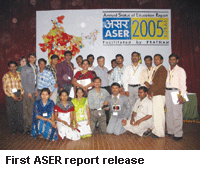 January 18, 2006. The Mumbai-based education NGO Pratham released its first ever Annual Status of Education Report, 2005 (ASER 2005) in New Delhi. The report, “a collective snapshot” compiled by 20,000 volunteers who fanned out across 485 of India’s 603 districts, is the first major independent audit of rural India’s elementary education system.
January 18, 2006. The Mumbai-based education NGO Pratham released its first ever Annual Status of Education Report, 2005 (ASER 2005) in New Delhi. The report, “a collective snapshot” compiled by 20,000 volunteers who fanned out across 485 of India’s 603 districts, is the first major independent audit of rural India’s elementary education system.
ASER 2005 revealed that almost 60 percent (i.e 105 million) of children in the age group seven-14 cannot read and compre-hend simple narratives of class II level difficulty and 35 percent (62 million) cannot read a simple paragraph of class I level difficulty — a damning indictment of the abysmal quality education being dispensed in the country’s 700,000 rural government and private primary schools. (EW cover story March 2006)
.gif) OBC reservations order
OBC reservations order
April 5, 2006. Union HRD minister Arjun Singh grabbed national attention with a bombshell announcement that the 17-party coalition United Progressive Alliance government at the Centre has approved his ministry’s proposal to reserve an additional 27 percent of capacity in all Central government promoted universities and institutes (JNU, IITs, IIMs, AIIMS, etc) for OBC (other backward class/caste) students. While this out-of-the-blue reservation diktat evoked studied criticism from the intelligentsia and media, the student community in north India, responded with nationwide protests. (EW cover story May 2006)
Apex court orders clean-up of student elections
September 22, 2006. In a landmark order, the Supreme Court endorsed the J.M. Lyngdoh Committee’s recommendations (submitted in July) on ways and means to clean up India’s notorious university and college elections. Under the order, a cap of Rs.5,000 has been imposed on poll expenses per candidate, and donations by way of money or printed material from political parties have been banned. Moreover student union office bearers must be full-time enroled students without any criminal record with at least 75 percent attendance, and be below 28 years of age.
Delhi high court bans nursery admission interviews
October 17, 2006. The Delhi high court banned pre-schools from conducting admission interviews of toddlers as well as their parents. The court accepted the recommendations of a five member committee headed by former CBSE chairman Ashok Ganguly, and directed pre-schools in the capital to implement them on a trial basis for one year.
Parliament passes OBC reservation Bill
December 2006. In a personal triumph for Union HRD minister Arjun Singh, Parliament passed the Central Educational Institutions (Reservation in Admission) Bill, 2006. The Act reserves an additional 27 percent of seats in over 100 Central government-sponsored higher education institutions for students from other backward castes (OBCs).
St. Stephen’s asserts Christian identity
June, 2007. The supreme council of St. Stephen’s College, Delhi (estb. 1881), widely regarded as the country’s premier liberal arts college, approved a resolution to reserve 40 percent of its annual intake of 400 students for the country’s 24 million-strong Christian community. The resolution created a new sub-quota of 25 percent for ‘Dalit Christians’.
The supreme council also accepted the “voluntary resignation” of Dr. Anil Wilson, who served as the college’s 11th principal for 16 years (1991-2007), and appointed pro-church hardliner Valson Thampu as the new principal of St. Stephen’s.
NUEPA Report exposes elementary education rot
July, 2007. Elementary Education in India 2005-06 — An Analytical Report, published by the National University of Educational Planning & Administration (NUEPA), Delhi and the first comprehensive national report on the status of elementary education, covering all of India’s 604 districts opined that, “the number of children dropping out before entering upper primary school is unacceptably high, and learning outcomes in primaries and upper primaries are not satisfactory”.
Among its exposés: 107,276 schools countrywide have only one classroom; 93 percent of private schools provide drinking water facilities as against only 81 percent of government schools; 70 percent of private schools provide common toilets for students cf. only 49 percent of government schools. (EW cover story September 2007)
EW Survey of India’s Most Respected Schools
 August 5, 2007. EducationWorld published the first ever survey of India’s Most Respected Schools. Conducted by the well-known market research firm IMRB in 15 cities across India, the survey rated and ranked 250 schools countrywide on 12 parameters of excellence — academic reputation, co-curricular education, sports education, quality of teachers, teacher-pupil ratio, leadership/management quality, infrastructure, honesty/integrity, quality of alumni, etc. (EW cover story August 2007)
August 5, 2007. EducationWorld published the first ever survey of India’s Most Respected Schools. Conducted by the well-known market research firm IMRB in 15 cities across India, the survey rated and ranked 250 schools countrywide on 12 parameters of excellence — academic reputation, co-curricular education, sports education, quality of teachers, teacher-pupil ratio, leadership/management quality, infrastructure, honesty/integrity, quality of alumni, etc. (EW cover story August 2007)
Independence Day booster for Indian education
August 15, 2007. Addressing the nation from the ramparts of Delhi’s historic Red Fort on the occasion of India’s 60th Independence Day (August 15), prime minister Dr. Manmohan Singh made several specific proposals to expand capacity in the education sector. Among them: promotion of 6,000 “new, high quality schools — one in every block of the country”; helping state governments to establish colleges in 370 under-served districts across the country; establishment of 30 new Central universities; promotion of eight new IITs, seven IIMs and 20 greenfield IIITs (Indian Institutes of Information Technology); 10,000 new vocational schools and 50,000 new Skill Development Centres. (EW cover story November 2007)
Compulsory rural service for medical students
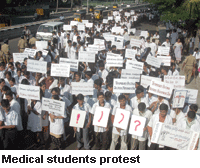 October, 2007. Union health minister Dr. Ambumani Ramadoss announced that a Bill proposing medical graduates be awarded their MBBS certificates only after they complete a year’s service in district or taluk hospitals and primary health centres, will be tabled in the winter session of Parliament. As per provisions of the Bill, during the rural service period medicos will receive a stipend of Rs.8,000 per month.
October, 2007. Union health minister Dr. Ambumani Ramadoss announced that a Bill proposing medical graduates be awarded their MBBS certificates only after they complete a year’s service in district or taluk hospitals and primary health centres, will be tabled in the winter session of Parliament. As per provisions of the Bill, during the rural service period medicos will receive a stipend of Rs.8,000 per month.
The proposed legislation, applicable to all 262 government and private medical colleges in the country, provoked unprecedented protests by medical students countrywide. (EW cover story January 2008)
Education gets top billing in XIth Plan
November, 2007. The Planning Commission approved a 20 percent hike in the education outlay of the Eleventh Plan (2007-12). The Plan has divided the education sector into elementary, adult, secondary, and higher education. The outlay of Rs.125,000 crore for elementary education reflects a substantial increase from the Rs.30,000 crore allocated in the Tenth Plan period, while adult and secondary education have been allocated Rs.6,000 crore and Rs.53,000 crore, respectively. Moreover, the plan document provides Rs.84,000 crore for higher and technical education in the country.
New IITs & IIMs proposed
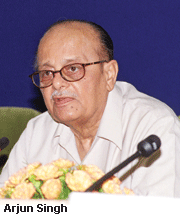 March 28, 2008. Union HRD minister Arjun Singh announced the promotion of eight new IITs, seven IIMs and 14 Central universities. The outlay for each new IIT with a capacity of 860 students is estimated at Rs.760 crore, and for each IIM with an annual intake of 180 students at Rs.210.25 crore.
March 28, 2008. Union HRD minister Arjun Singh announced the promotion of eight new IITs, seven IIMs and 14 Central universities. The outlay for each new IIT with a capacity of 860 students is estimated at Rs.760 crore, and for each IIM with an annual intake of 180 students at Rs.210.25 crore.
Moreover Singh also announced the promotion of two Central government funded (Rs.150 crore each) IISERs (Indian Institutes of Science Education and Research) in Bhopal and Thiruva-nanthapuram. The infrastructure cost of each Central university with a school of medicine and a capacity of 12,700 students, is estimated at Rs.720 crore spread over a period of nine years.
EW presents supplementary budget for education
.gif) April 6, 2008. Disappointed with the Union budget 2008-09, EducationWorld presented the blueprint of a supplementary education budget. Conceptualised with the aid and advice of Dr. A.S. Seetharamu, professor of education at the Institute for Social & Economic Change, Bangalore, the EW supplementary budget offered a road map to equip every government primary countrywide with laboratory, library, drinking water and toilet facilities.
April 6, 2008. Disappointed with the Union budget 2008-09, EducationWorld presented the blueprint of a supplementary education budget. Conceptualised with the aid and advice of Dr. A.S. Seetharamu, professor of education at the Institute for Social & Economic Change, Bangalore, the EW supplementary budget offered a road map to equip every government primary countrywide with laboratory, library, drinking water and toilet facilities.
The EW supplementary budget calculated the one-time capital cost of equipping 1.05 million government and aided schools with adequate lab-lib-lav facilities at Rs.47,725 crore — a mere 1 percent of India’s GDP. (EW cover story April 2008)
Supreme Court approves OBC reservations
April 10, 2008. Delivering its verdict in Ashoka Kumar Thakur vs. Union of India & Ors, a five-judge bench of the Supreme Court approved the 93rd Amendment to the Constitution and the consequential Central Educational Institutions (Reservation in Admission) Act, 2006. This legislation reserves an additional (i.e in addition to the 22.5 percent reserved for scheduled castes and scheduled tribes) 27 percent of seats in the country’s 100 Central government promoted institutions of higher education, for OBC (other backward castes/classes) students. However the court observed that aggregate reservation in Central government institutions will not be permitted to cross the 50 percent threshold set by the Supreme Court. (EW cover story May 2008)
RTE Bill, 2008 tabled
December 15, 2008. The Right to Education Bill 2008, cleared by the cabinet in November, was tabled in the Rajya Sabha by Union HRD minister of state M.A.A. Fatmi, ending months of speculation over the fulfilment of a promise made by the UPA government in 2004, to enact it during its term.
Great expectations of Kapil Sibal
.gif) May 22, 2009. Following the return to power in Delhi of the Congress-led UPA-2 government in the general election of May, Kapil Sibal took charge of the Union human resource development ministry. At a crowded press conference in Delhi, Sibal outlined a 10-point agenda for radical reform of primary-secondary educa-tion, and 24 proposals for recasting higher education. (EW cover story July 2009)
May 22, 2009. Following the return to power in Delhi of the Congress-led UPA-2 government in the general election of May, Kapil Sibal took charge of the Union human resource development ministry. At a crowded press conference in Delhi, Sibal outlined a 10-point agenda for radical reform of primary-secondary educa-tion, and 24 proposals for recasting higher education. (EW cover story July 2009)
Parliament approves RTE Bill
August 4, 2009. The Lok Sabha unanimously approved The Right of Children to Free and Compulsory Education Bill, 2009 (earlier known as the Right to Education Bill), which promises to provide free and compulsory education to all children aged between six to 14 years. The Bill which was passed by the Rajya Sabha on July 20, is awaiting presidential assent .